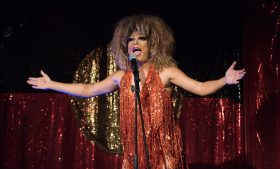Summer days mean the beach or the bush for many Australians. But when the temperature is beyond comfort levels consumers gravitate towards any place with decent air-conditioning. The big shopping centres and the cinemas are busier than the beaches.
Arts institutions traditionally prefer to lure audiences on the strength of their content rather than the quality of their cooling systems. But some are starting to understand the value of consumer marketing that focuses on the broader social and environmental experience, allowing art appreciation to follow such motivations as a change of scene, an impressive date or just somewhere to get out of the heat.
People go to ‘the movies’ with no particular film in mind and browse the mall just for somewhere to go. Why not entice them to a gallery or performance space for the same reasons?
This summer the National Gallery of Victoria launched a marketing campaign aimed beyond the standard gallery crowd with the slogan, ‘Summer is best spent indoors’. The campaign was remarkably successful, providing a 24% increase in visitors to an institution that has traditionally been focused on building winter audiences.
With poor brand image identified as a problem for art museums, new NGV Gallery Director Tony Ellwood took a deliberate decision to pitch for audiences after an outing rather than specifically an art experience.
He says galleries have social value to sell that they often don’t appreciate. ‘We are democratic, safe, affordable. When you walk in the door you are safe, you are welcome and you are not made to spend money you don’t have.’
Of course the art matters. This summer at the NGV offered audiences a nice balance: the appealing Neo-Impressionist exhibitionist, the influential work of the Thomas Demand and Jeff Wall photographic exhibitions and the more adventurous Rally, exhibiting contemporary Indonesian art from Jompet Kuswidananto & Eko Nugroho.
But it is the marketing campaign rather than any kind of blockbuster that seems to have pushed up the numbers and that was about social positioning rather than art.
Ellwood’s experience as director of the Queensland Art Gallery|Gallery of Modern Art (QAGOMA) showed him the gallery could be a powerful refuge for audiences. During the Queensland floods in 2008 QAGOMA was showing Optimism, a brave collection of contemporary Australian work that was not expected to draw huge audiences. But people flocked to the gallery, drawn as much by the mood and the opportunity to go somewhere away from depressing current events as by any specific desire to look at the work.
Galleries are particularly well placed to become public venues with free permanent collections. But price is not always the issue. Those who hang out at the mall, movies, pub or casino dig into their pockets. Breaking into the outing sector is more about honouring diverse motivations than breaking a price barrier.
Historically social pressure delivered major sectors of the audience who went to the opera or an opening to ‘be seen’ rather than to see. In our less stratified and more individualistic society we need to find new social reasons to get people inside our arts institutions.
One original motivation is the invention of art museums as single scenes. In a study of the introduction of late night programming in a number of American museums, Amy Solomon Cretaro found several museums were consciously creating a singles scene. The Walker Art Center in Minneapolis even claims in its marketing that several marriages have begun with meetings at the museum.
Parents looking for something to do with the kids on school holidays are an established market as the proliferation of family programming makes clear. All those ‘Build a skyscraper’ and ‘Draw your own portrait’ sessions are a good example of how profitable it can be to target a sector looking for something to do .
Similar enticements can work for adults. Canberra audiences can have French-style high tea at Toulouse-Lautrec, visitors to the Brett Whiteley studio in Sydney can hear poetry readings and Adelaide audiences can see films of Jane Eyre and Mansfield Park as part of the Turner exhibition. Performance, parties and events are targeted at audiences interested in a mood, an environment or space to spend time with friends.
Purism is still an issue for many arts institutions. With tremendous effort expended on the quality of the work, few curators derive much comfort from the idea that some audience members don’t particularly care what’s on the walls when they enter a gallery. Directors who invest months in selecting and polishing performance work feel the same way.
But the uncommitted audience is a tremendous opportunity. Visitors come without preconceptions or expectations and, having invested little, they are well placed to be pleasantly surprised. And the work can’t do its magic until you get them inside.
There is a big audience out there looking for experiences and outings and arts organisations are doing more to capture them.





